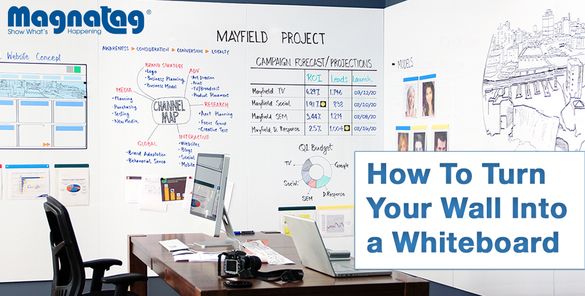Magnatag InSight
The whiteboard and how it helps us brainstorm, innovate, motivate and create
Whiteboard / WhiteWall®
Blog posts that specifically feature stories with whiteboards or WhiteWalls.

How To Turn Your Wall Into a Whiteboard
Tue Aug 3 2021Whiteboard walls are the truest form of unfiltered expression. There’s no barrier to entry; if you have an idea, you can write it on the wall. It’s that simple. However, turning a wall into a whiteboard is a more daunting task than the internet would have you believe. If you’re going the DIY method, you’ll need to follow these steps to turn your wall into a whiteboard:
- Strip paint
- Repair drywall to create a smooth surface (sand)
- Apply primer to the wall
- Depending on which route you choose to take, you’ll need to apply either an industrial adhesive to stick a laminate sheet on the wall or apply specialty paint to actually provide the wall with dry-erase properties.
Commercial-grade whiteboard walls are usually designed using a series of steel-backed panels that mount directly to the wall, providing an element of durability and magnetism that you cannot find in traditional DIY whiteboard walls. Over the past few years, the whiteboard wall panel space has diversified, incorporating dozens of material options to choose from, the most common of which include painted-steel, porcelain, and glass surfaces.
Before deciding on a whiteboard wall panel, you need to keep in mind that professional installers are typically billed at an hourly rate. A whiteboard wall installation can range anywhere from 30-minutes to days depending on the number of walls and classification of whiteboard panels in play. For instance, whiteboard wall panels that designate specific left and right-end panels require installers to fully layout and map exact panel locations prior to installation. In contrast, wall panels without designations can be installed in any order, directly out of the box. Alternatively, whiteboard wall panels that use splines and mounting trim will require installers to make cuts and modifications to the material prior to the install. While these modifications and requirements may only seem like minor pain points, multiplying these requirements across dozens of walls and panels can quickly amount to hours of additional labor costs.
At Magnatag, we've developed a line of magnetic whiteboard wall panels that streamline the installation process to make it fast, simple, and secure while maintaining a durable writing surface. Our line of WhiteWall® dry-erase wall panels utilize a patented mounting bracket system that can be installed in a matter of minutes with the help of a power drill, level, and a few additional hands. All that's required for installation is to mount the brackets onto the wall and slide panels into their designated position—it's that simple. Since WhiteWall panels are designed with precision-formed self-edges, you can create a smooth, uninterrupted writing surface without the need to specify end panels or modify mounting brackets. We also manufacture WhiteWalls using our proprietary porcelain-like Magnalux® dry-erase surface. Magnalux is a painted enamel surface is evenly applied to steel that will not stain, crack or fade after years of daily use.
Before you start looking into turning your wall into a whiteboard, it's important to be mindful of the two primary elements that go into a successful whiteboard wall transformation: ease of installation and durability. While cost-effective, DIY whiteboard wall transformations can take hours to prep and fail to provide the long-lasting durability found in commercial whiteboard wall panels. Commercial-grade whiteboard wall panels that rely on splines and mounting trim can take hours to install, and in turn, increase labor costs. Magnatag WhiteWall magnetic dry-erase whiteboard wall panels combine the best properties of commercial whiteboard wall panels with a simple installation process that you can complete in minutes. If you're in the market to transform your wall into a creative hotspot, Magnatag is the best place to start your journey.

Finding The Perfect Location For Your Dry-Erase Board
Mon Dec 3 2018Understanding the Relationship Between Positioning & Display Size
Display size and positioning are the two most significant factors that one must consider before choosing a size for your whiteboard—both of which vary depending on the size of the space. Ultimately, the two elements share a unique relationship, as both positioning and size directly relate to text and images displayed on the board and how we interpret content in a presentation space. The size of a surface directly links to the size of the room, and contrariwise, the size of a room implicates how large a surface can be and its final location.
As a general rule of thumb, we recommend mounting your whiteboard no higher than seven feet above the base of the floor and no lower than three-feet. To be more specific, the top of a 4 x 6’ whiteboard should hang 84” off the floor; a 3 x 4’ board should be 78”, and a 2 x 3’ should hang no higher than 72”. You should always place your dry-erase board in a position that lines up in direct eyesight of the primary user. The bottom line is you never want to place your whiteboard in a place that’s out of reach. Of course, this is just the guideline that we practice in our facility, and that’s not to say it’s the cardinal rule for whiteboard installations. If you want to take a deeper dive into the science of whiteboard installations, including ADA rules and guidelines for accessibility, we’ve put together this collection of rules and guidelines that can help you master your next whiteboard installation.
The 4/6/8 Rule
At its core, the 4/6/8 rule functions as a set of standards that determine the optimal display image size in any given presentation space. Depending on the intent of your dry-erase board—be it passive viewing, general information gathering, or inspection-based viewing—the image height of the board should be either 1/4th, 1/6th, or 1/8th the distance to the furthest viewer.
1/8th or Passive Viewing
The 1/8th viewing distance is perfect for spaces where general visual content will be displayed-think along the lines of webcam calls, movies, and YouTube videos. Typically, this content doesn't involve detail-oriented graphics, and when paired with a combination of audio and visual cues, can be easily digested. For example, in the case that you're setting up a project where passive viewing is the primary function of the display surface, and the furthest viewer is 30' from the board, the minimum image height your display surface can support should be 3.75' tall.
1/6th or General Viewing
The 1/6th viewing distance works best in environments where information is retained but is not critical for comprehension of the presentation as a whole (PowerPoint presentations, classroom notes, word processing, etc.). This type of content is the most common use case for general conference rooms in the US where a discussion is driven by what's displayed but does not necessarily require an in-depth inspection of an image or diagram. So, for the room where the furthest viewer is 30' from the display unit, the minimum height of the display surface should be just under 5' tall.
1/4th or Detailed/Inspection/Analytical Viewing
The 1/4th viewing distance is the most intimate and compelling angle of the 4/6/8 rule. Specifically used when inspecting highly detailed graphs and documents, like a CAD drawing or medical chart, this viewing distance should only be considered for presentation spaces where analytical interpretation and discussion of the display's content is of primary focus. If we were to revisit once again the presentation space where the furthest viewer would sit 30' away from the board or screen, the ideal height for the display unit would be 7.5'.
Generally speaking, most projects that require a whiteboard should fit nicely into one of these three categories. In the case that you may not know the exact intent of the presentation space, we recommend going with the 1/6th distance, as the majority of businesses and schools typically keep detailed inspection-based discussions to a more intimate small-group environment.
Determining The Height of Your Board
The ultimate goal when hanging any visual display surface is to provide a clear sightline for everyone in a designated presentation space. Finding the perfect height to accomplish this task is easier said than done, and quite honestly, there's no industry standard to get you started—but there are a few rules and regulations that can point you in the right direction.
Use ADA Accessibility Rules as a Baseline
In 2010 the Department of Justice published revisions of the Americans With Disabilities Act (ADA) detailing the minimum and height requirements for signage as it relates to the ground level. The regulations state that the minimum height for signage be 48 inches above the ground, with the maximum height hanging 60 inches above the floor. While most visual display units do not qualify as "signage" under the ADA guidelines, many experts recommend using the 48-inch minimum as a preventative baseline for an end-user. The thought behind this recommendation is that the average height of a seated individual measures 36", and with the bottom of the display unit hanging at 48", the average viewer would not have their view of the display surface obstructed by another seated individual.
The 1/3rd Rule
According to joint recommendations developed by the leading global authority in home theater systems, CEDIA, and the Society of Motion Picture and Television Engineers, an ideal view of a display surface should not have an angle of greater than 15 degrees to the top or bottom of the screen. The 1/3rd rule takes note of CEDIA's recommendations and utilizes a formulaic approach similar to what's found in the 4/6/8 law to determine the best display height for any given space. Ideally, an architect or contractor should measure 1/3rd the distance between the display unit and the furthest seat in the room and use that measurement to determine the final height of the display unit. By sticking to this formula, the height of the display scales with the audience and limits the line of sight for those located in the back of the room.
In Conclusion
Both the size and location of your visual display unit can have a tremendous impact on the surface’s end-user, and as a result, you should treat every surface you install on a case-by-case basis. It is essential to understand that available space ultimately dictates the final placement of your whiteboard.
